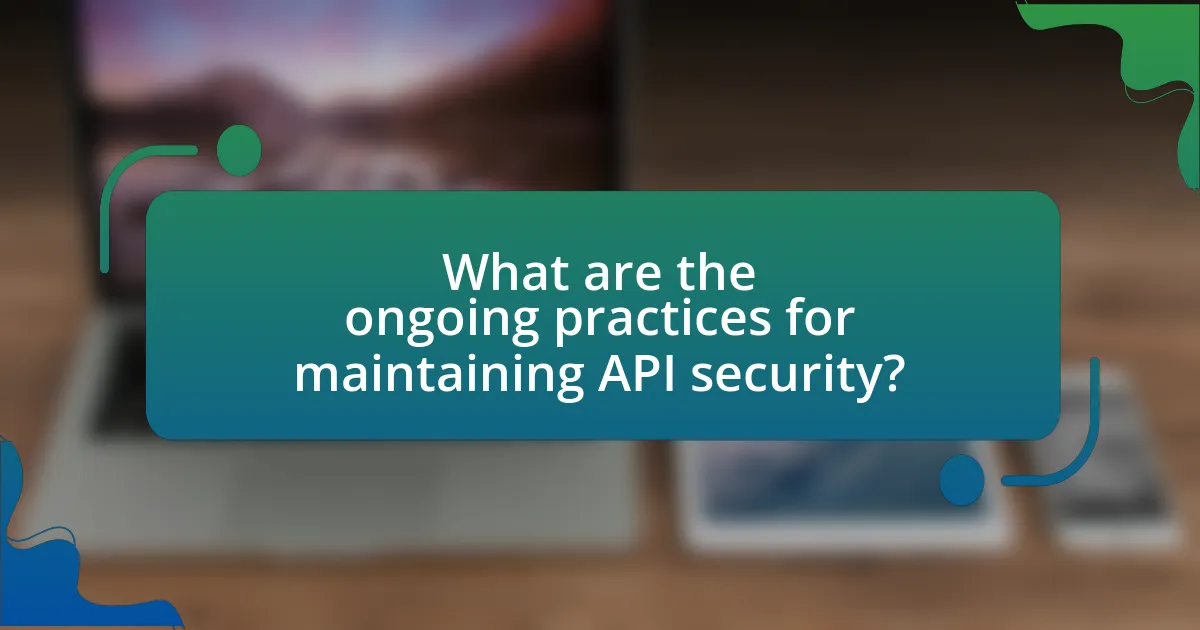The article focuses on best practices for secure API development, emphasizing the importance of implementing robust authentication and authorization mechanisms, utilizing HTTPS for data encryption, validating input to prevent injection attacks, and applying rate limiting to mitigate abuse. It outlines the risks associated with insecure APIs, such as data breaches and unauthorized access, and highlights the significance of secure coding practices and regular security audits. Additionally, the article discusses tools and technologies that support secure API development, as well as ongoing practices for maintaining API security, ensuring that organizations can protect sensitive information and uphold user trust.

What are the Best Practices for Secure API Development?
The best practices for secure API development include implementing authentication and authorization, using HTTPS, validating input, and applying rate limiting. Authentication ensures that only authorized users can access the API, while authorization controls what actions they can perform. HTTPS encrypts data in transit, protecting it from eavesdropping. Input validation prevents injection attacks by ensuring that only properly formatted data is accepted. Rate limiting protects against abuse by restricting the number of requests a user can make in a given timeframe. These practices are essential for safeguarding sensitive information and maintaining the integrity of the API.
Why is secure API development important?
Secure API development is important because it protects sensitive data and ensures the integrity of applications. APIs often serve as gateways to critical systems and data, making them prime targets for cyberattacks. According to a report by the Open Web Application Security Project (OWASP), APIs are frequently exploited due to vulnerabilities such as insufficient authentication and authorization, which can lead to data breaches. By implementing secure development practices, organizations can mitigate risks, safeguard user information, and maintain trust with their customers.
What risks are associated with insecure APIs?
Insecure APIs pose several significant risks, including data breaches, unauthorized access, and service disruptions. Data breaches can occur when sensitive information is exposed due to inadequate authentication or encryption, leading to potential financial loss and reputational damage for organizations. Unauthorized access can happen if APIs lack proper access controls, allowing malicious actors to manipulate or retrieve data without permission. Additionally, insecure APIs can be exploited to launch denial-of-service attacks, disrupting services and affecting user experience. According to a report by the API Security Project, 94% of organizations have experienced an API security incident, highlighting the critical need for secure API development practices.
How can secure APIs protect sensitive data?
Secure APIs protect sensitive data by implementing authentication, encryption, and access control mechanisms. Authentication ensures that only authorized users can access the API, typically through methods like OAuth or API keys. Encryption protects data in transit and at rest, using protocols such as HTTPS and AES, which safeguard against interception and unauthorized access. Access control mechanisms, such as role-based access control (RBAC), limit user permissions based on their roles, ensuring that sensitive data is only accessible to those who need it. These practices collectively reduce the risk of data breaches and unauthorized access, thereby enhancing the overall security of sensitive information.
What are the key principles of secure API design?
The key principles of secure API design include authentication, authorization, data encryption, input validation, and rate limiting. Authentication ensures that only legitimate users can access the API, while authorization controls what authenticated users can do. Data encryption protects sensitive information during transmission, and input validation prevents malicious data from being processed. Rate limiting helps mitigate abuse by restricting the number of requests a user can make in a given timeframe. These principles are essential for safeguarding APIs against common vulnerabilities and attacks, such as unauthorized access and data breaches.
How does authentication enhance API security?
Authentication enhances API security by verifying the identity of users or systems accessing the API. This process ensures that only authorized entities can interact with the API, thereby preventing unauthorized access and potential data breaches. For instance, implementing OAuth 2.0 as an authentication method allows APIs to securely delegate access without sharing credentials, significantly reducing the risk of exposure. Furthermore, according to a 2021 report by the Identity Theft Resource Center, 80% of data breaches involved compromised credentials, highlighting the critical role of robust authentication mechanisms in safeguarding sensitive information.
What role does authorization play in secure API access?
Authorization is crucial for secure API access as it determines which users or systems have permission to access specific resources or perform certain actions. By implementing robust authorization mechanisms, such as OAuth or role-based access control, APIs can ensure that only authenticated users with the appropriate permissions can interact with sensitive data or functionalities. This minimizes the risk of unauthorized access and potential data breaches, as evidenced by the fact that 80% of data breaches involve compromised credentials, highlighting the importance of effective authorization in safeguarding API endpoints.
What common vulnerabilities should be addressed in API development?
Common vulnerabilities that should be addressed in API development include insufficient authentication, lack of rate limiting, and improper input validation. Insufficient authentication can lead to unauthorized access, as seen in the 2019 Capital One breach, where a misconfigured API allowed access to sensitive data. Lack of rate limiting can expose APIs to denial-of-service attacks, which can overwhelm the server and disrupt service. Improper input validation can result in injection attacks, such as SQL injection, which can compromise the integrity of the database. Addressing these vulnerabilities is crucial for maintaining the security and integrity of APIs.
What is SQL injection and how can it be prevented?
SQL injection is a type of cyber attack where an attacker inserts or manipulates SQL queries through input fields to gain unauthorized access to a database. This vulnerability arises from insufficient input validation and improper handling of user inputs in applications. To prevent SQL injection, developers should implement parameterized queries or prepared statements, which separate SQL code from data, ensuring that user inputs are treated as data only. Additionally, employing input validation, using stored procedures, and applying the principle of least privilege for database access can further mitigate the risk of SQL injection attacks. These practices are essential for maintaining secure API development and protecting sensitive data.
How can cross-site scripting (XSS) attacks be mitigated?
Cross-site scripting (XSS) attacks can be mitigated by implementing input validation, output encoding, and employing Content Security Policy (CSP). Input validation ensures that only expected data is accepted, reducing the risk of malicious scripts being processed. Output encoding transforms user input into a safe format before rendering it in the browser, preventing execution of any embedded scripts. Additionally, CSP acts as a security layer that helps detect and mitigate certain types of attacks, including XSS, by specifying which dynamic resources are allowed to load. These practices are supported by the OWASP XSS Prevention Cheat Sheet, which outlines effective strategies for preventing XSS vulnerabilities in web applications.
How can developers implement secure coding practices?
Developers can implement secure coding practices by adhering to established security guidelines and frameworks, such as the OWASP Top Ten, which identifies the most critical security risks to web applications. By following these guidelines, developers can mitigate vulnerabilities like SQL injection, cross-site scripting, and insecure deserialization. Additionally, employing code reviews, static code analysis tools, and regular security testing can help identify and rectify security flaws early in the development process. Research indicates that organizations implementing secure coding practices can reduce security incidents by up to 50%, highlighting the effectiveness of these measures in enhancing application security.
What coding standards should be followed for API security?
To ensure API security, developers should follow coding standards such as input validation, authentication, authorization, and secure data transmission. Input validation prevents malicious data from being processed, while robust authentication mechanisms, like OAuth 2.0, ensure that only authorized users can access the API. Authorization checks enforce user permissions, and secure data transmission should utilize HTTPS to protect data in transit. These standards are supported by the OWASP API Security Top 10, which outlines common vulnerabilities and best practices for securing APIs.
How can input validation prevent security breaches?
Input validation can prevent security breaches by ensuring that only properly formatted data is accepted by an application. This process helps to mitigate risks such as SQL injection, cross-site scripting (XSS), and buffer overflow attacks, which exploit unvalidated input to compromise systems. For instance, according to the Open Web Application Security Project (OWASP), improper input validation is a leading cause of web application vulnerabilities, accounting for a significant percentage of security incidents. By implementing strict validation rules, developers can filter out malicious data, thereby protecting sensitive information and maintaining the integrity of the application.

What tools and technologies support secure API development?
Tools and technologies that support secure API development include API gateways, authentication frameworks, encryption protocols, and security testing tools. API gateways, such as Amazon API Gateway and Apigee, manage traffic and enforce security policies, ensuring that only authorized users can access the API. Authentication frameworks like OAuth 2.0 and OpenID Connect provide secure methods for user authentication and authorization. Encryption protocols, including TLS (Transport Layer Security), protect data in transit, while tools like OWASP ZAP and Postman can be used for security testing to identify vulnerabilities in APIs. These tools and technologies collectively enhance the security posture of API development by implementing best practices and mitigating risks.
What are the best tools for API security testing?
The best tools for API security testing include Postman, OWASP ZAP, Burp Suite, and SoapUI. Postman is widely used for API development and testing, offering features for automated security testing. OWASP ZAP is an open-source tool that helps identify vulnerabilities in web applications, including APIs, through automated scanning and manual testing. Burp Suite provides a comprehensive platform for web application security testing, including API security, with features for intercepting and modifying requests. SoapUI specializes in testing SOAP and REST APIs, allowing users to perform security testing through its extensive testing capabilities. These tools are recognized in the industry for their effectiveness in identifying and mitigating security risks in APIs.
How can static analysis tools improve code security?
Static analysis tools improve code security by automatically identifying vulnerabilities and coding errors in the source code before the software is executed. These tools analyze the codebase for common security flaws, such as buffer overflows, SQL injection, and cross-site scripting, which can lead to exploitation if left unaddressed. For instance, a study by the National Institute of Standards and Technology (NIST) found that static analysis can detect up to 80% of vulnerabilities in code, significantly reducing the risk of security breaches. By integrating static analysis into the development process, organizations can ensure that security issues are identified early, allowing developers to remediate them before deployment, thus enhancing the overall security posture of the application.
What role do dynamic analysis tools play in API security?
Dynamic analysis tools play a crucial role in API security by identifying vulnerabilities during runtime, allowing developers to detect and remediate security issues before deployment. These tools simulate attacks on the API to uncover weaknesses such as improper authentication, data exposure, and injection flaws. For instance, according to a study by the Open Web Application Security Project (OWASP), dynamic analysis can reveal up to 80% of security vulnerabilities that static analysis might miss, highlighting its effectiveness in securing APIs.
How can encryption enhance API security?
Encryption enhances API security by protecting sensitive data during transmission and storage. By encrypting data, APIs ensure that even if intercepted, the information remains unreadable to unauthorized users. For instance, using protocols like HTTPS, which employs TLS (Transport Layer Security), encrypts data in transit, safeguarding it from eavesdropping and man-in-the-middle attacks. According to a report by the Ponemon Institute, 70% of organizations that implemented encryption saw a significant reduction in data breaches, highlighting its effectiveness in securing APIs.
What types of encryption should be used for data in transit?
Transport Layer Security (TLS) should be used for encrypting data in transit. TLS provides a secure channel over a computer network and is widely adopted for securing communications on the internet. It ensures that data transmitted between clients and servers is encrypted, protecting it from eavesdropping and tampering. According to the Internet Engineering Task Force (IETF), TLS is the successor to Secure Sockets Layer (SSL) and is the standard protocol for securing internet communications, making it essential for secure API development.
How does encryption at rest protect sensitive information?
Encryption at rest protects sensitive information by converting data into a format that is unreadable without the appropriate decryption key. This process ensures that even if unauthorized individuals gain access to the physical storage medium, they cannot interpret the data without the key. For instance, according to the National Institute of Standards and Technology (NIST), encryption at rest is a critical component of data security strategies, as it mitigates risks associated with data breaches and unauthorized access. By implementing strong encryption algorithms, organizations can safeguard sensitive information such as personal identification details, financial records, and confidential business data, thereby maintaining compliance with regulations like GDPR and HIPAA.

What are the ongoing practices for maintaining API security?
Ongoing practices for maintaining API security include implementing authentication and authorization protocols, regularly updating and patching APIs, conducting security assessments, and monitoring API traffic for anomalies. Authentication and authorization ensure that only legitimate users can access the API, with methods such as OAuth 2.0 and API keys being widely adopted. Regular updates and patches address vulnerabilities as they are discovered, which is critical given that 80% of breaches involve known vulnerabilities. Security assessments, including penetration testing and code reviews, help identify weaknesses before they can be exploited. Monitoring API traffic allows for the detection of unusual patterns that may indicate an attack, enabling timely responses to potential threats.
How can regular security audits improve API security?
Regular security audits enhance API security by identifying vulnerabilities and ensuring compliance with security standards. These audits systematically evaluate the API’s architecture, code, and configurations, allowing organizations to detect weaknesses such as outdated libraries, misconfigurations, or insecure endpoints. For instance, a study by the Ponemon Institute found that organizations conducting regular security audits experienced 50% fewer data breaches compared to those that did not. This proactive approach not only mitigates risks but also fosters a culture of security awareness, ultimately leading to more robust API protection.
What should be included in an API security audit checklist?
An API security audit checklist should include authentication mechanisms, authorization controls, data encryption, input validation, logging and monitoring, error handling, rate limiting, and security testing. Authentication mechanisms ensure that only authorized users can access the API, while authorization controls verify that users have permission to perform specific actions. Data encryption protects sensitive information during transmission and storage. Input validation prevents injection attacks by ensuring that only valid data is processed. Logging and monitoring facilitate the detection of suspicious activities, and error handling ensures that sensitive information is not exposed in error messages. Rate limiting protects against abuse by controlling the number of requests a user can make. Security testing, including vulnerability assessments and penetration testing, identifies potential weaknesses in the API. These components are essential for maintaining the integrity and security of APIs, as highlighted by industry standards such as OWASP’s API Security Top 10.
How often should API security audits be conducted?
API security audits should be conducted at least annually. Regular audits help identify vulnerabilities and ensure compliance with security standards. According to the OWASP API Security Top 10, frequent assessments are crucial as they address evolving threats and changes in the API landscape. Additionally, organizations should consider conducting audits after significant changes to the API or its environment, such as updates or new integrations, to maintain a robust security posture.
What are the best practices for monitoring API security?
The best practices for monitoring API security include implementing rate limiting, logging and analyzing API requests, using API gateways, and employing security information and event management (SIEM) systems. Rate limiting helps prevent abuse by controlling the number of requests a user can make in a given timeframe, thereby reducing the risk of denial-of-service attacks. Logging and analyzing API requests allows for the identification of unusual patterns that may indicate security breaches, enabling timely responses to potential threats. API gateways serve as a centralized point for managing and securing API traffic, providing features like authentication and access control. Finally, SIEM systems aggregate and analyze security data from various sources, facilitating real-time monitoring and incident response. These practices collectively enhance the security posture of APIs by ensuring continuous oversight and rapid detection of vulnerabilities.
How can logging and monitoring detect security incidents?
Logging and monitoring can detect security incidents by capturing and analyzing system events and user activities in real-time. This process enables organizations to identify unusual patterns, such as unauthorized access attempts or data exfiltration, which may indicate a security breach. For instance, according to the 2021 Verizon Data Breach Investigations Report, 81% of hacking-related breaches leveraged stolen or weak passwords, highlighting the importance of monitoring login attempts. By maintaining detailed logs and employing automated monitoring tools, organizations can quickly respond to potential threats, thereby minimizing damage and enhancing overall security posture.
What metrics should be tracked for API security performance?
Key metrics to track for API security performance include the number of API calls, error rates, response times, authentication failures, and the frequency of security incidents. Monitoring the number of API calls helps identify usage patterns and potential abuse, while error rates indicate issues that may arise from security misconfigurations or attacks. Response times are crucial for assessing performance under load, which can be affected by security measures. Authentication failures highlight potential unauthorized access attempts, and tracking security incidents provides insight into vulnerabilities and the effectiveness of security protocols. Collectively, these metrics enable organizations to evaluate and enhance their API security posture effectively.
What practical tips can developers follow for secure API development?
Developers can enhance API security by implementing authentication and authorization mechanisms, such as OAuth 2.0 and API keys. These methods ensure that only authorized users can access the API, reducing the risk of unauthorized access. Additionally, developers should validate and sanitize all inputs to prevent injection attacks, which are among the most common vulnerabilities in APIs. According to the OWASP Top Ten, injection flaws are a critical risk, emphasizing the need for input validation.
Furthermore, employing HTTPS for all API communications protects data in transit from eavesdropping and man-in-the-middle attacks. Regularly updating and patching API dependencies is crucial, as outdated libraries can introduce vulnerabilities. The National Vulnerability Database reports that many breaches occur due to unpatched software.
Lastly, implementing rate limiting and logging can help detect and mitigate abuse, ensuring that the API remains secure against denial-of-service attacks. By following these practical tips, developers can significantly improve the security posture of their APIs.
How can developers stay updated on API security trends?
Developers can stay updated on API security trends by regularly following industry publications, participating in security-focused forums, and attending relevant conferences. Engaging with resources such as the OWASP API Security Top 10, which outlines the most critical API security risks, provides concrete insights into current vulnerabilities. Additionally, subscribing to newsletters from cybersecurity organizations and utilizing platforms like GitHub to monitor security-related projects can enhance awareness of emerging threats and best practices.
What resources are available for learning about secure API practices?
Comprehensive resources for learning about secure API practices include the OWASP API Security Top 10, which outlines common vulnerabilities and mitigation strategies, and the API Security Best Practices guide by the Cloud Security Alliance, providing detailed recommendations for secure API design and implementation. Additionally, the book “API Security in Action” by Neil Madden offers practical insights and real-world examples of securing APIs. These resources are widely recognized in the industry for their authoritative content and practical applicability, making them essential for developers and security professionals aiming to enhance their understanding of secure API practices.



